Homemade Italian bread is actually very easy to make and tastes delicious! While you could buy a loaf of Italian bread from the grocery store, baking bread is fun and satisfying. Warm, toasty bread from the oven is pure comfort food.
I love my 1963 homemade white bread for sandwiches and everything peasant bread for snacking, but this Italian loaf is perfect with a bowl of spaghetti, or alongside a plate of my crockpot roast beef!

Italian Bread Recipe
There’s a definite difference between French bread and Italian bread. Most of the general population either doesn’t know or simply doesn’t care, but there are differences nonetheless.
Basically though, French bread only uses flour, yeast, salt, and water. In fact, French law states that added oils or fats are prohibited. A French loaf is usually long and thin, while an Italian loaf is shorter and wider.

Expert Tips & FAQs
In this section I like to provide tips and recommendations about the different ingredients used. I also try to answer questions about substitutions. You will find the full list of ingredients with measurements in the printable recipe card at the end of this post.
- You can use the packets of active dry yeast available at any grocery store. I bake a lot of bread, so I prefer to by SAF instant yeast in larger packages.
- When a bread recipe calls for warm water, the temperature should be around 110 degrees F. If the water is too hot it will kill the yeast, and too cold will delay the rise process.
- You’ll also use hot water in this recipe, but since you are mixing it with other ingredients before adding the yeast mixture it will be fine. You want hot tap water, not boiling water.
- This recipe calls for vegetable oil, but olive oil can also be used.
- We are using all-purpose flour, white not wheat, to make this bread.
You can freeze the dough for up to 3 months. If kept in the fridge, the yeast will continue to grow, even if it’s slowly. This can be done for about a day, but I wouldn’t do it much longer than that. Wrap the dough tightly in plastic wrap and store in freezer bags. When ready to bake, remove from the freezer and thaw at room temperature. It will take about 4 hours to thaw. Then bake according to the recipe.
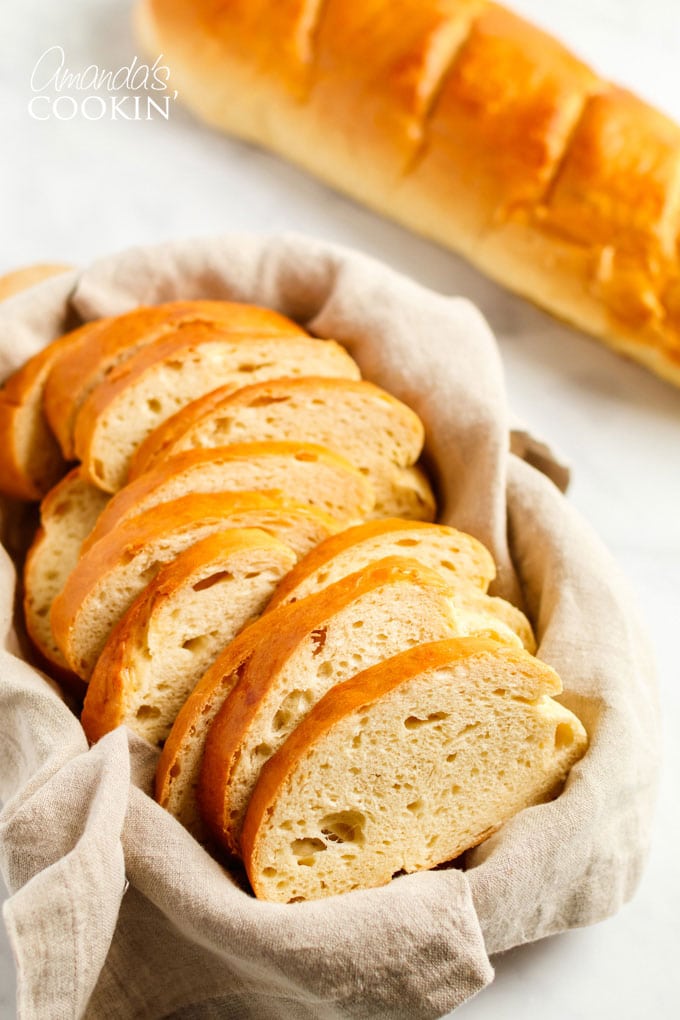
Helpful kitchen tools:
- Mixing bowls
- Stand mixer or hand mixer
- Baking sheets
- Wire cooling rack
- Pastry brush
- Rolling pin
- Bread knife
Bread Machine instructions are at the end!
How to Make Italian Bread
- Dissolve yeast, 1/2 cup warm water, and 1/2 teaspoon granulated sugar in a small bowl.
A NOTE ABOUT YEAST: You can use either active dry yeast or instant yeast. If you use active dry yeast it needs to be proofed in order for it to be reactivated. Instant dry yeast doesn’t need proofing. Active dry yeast must be reactivated by proofing in warm water, or the bread won’t rise properly. This process is to “prove” that the yeast is still alive.
- In a large bowl or stand mixer, combine 2 cups hot water, 3 tablespoons granulated sugar, the salt, and the oil. Add 3 cups of flour to the mixture in this large bowl/mixer and mix well.
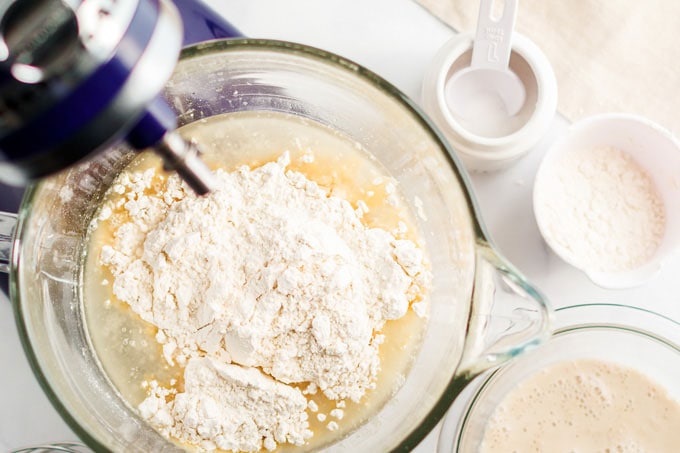
- Stir in yeast mixture.
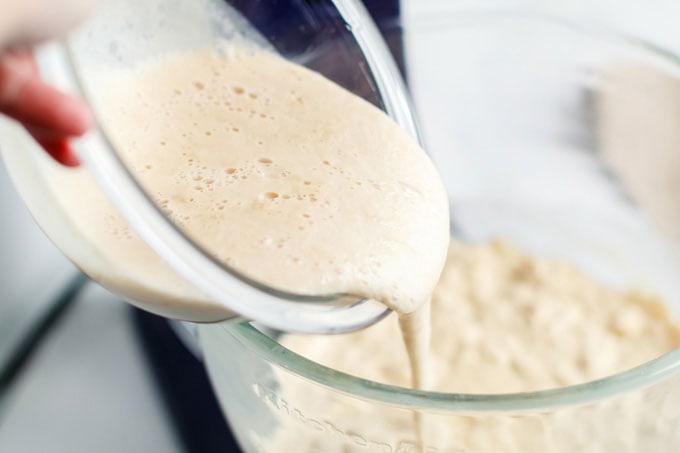
- Add 2 – 3 cups more flour and mix until well blended. (At this point your dough will still be quite sticky).

- Leave in bowl, cover with a towel and let rise for 1 hour. (If using a mixer, remove the bowl from the mixer and cover it with a towel. Otherwise your paddle attachment or dough hook will get covered in dough when it rises).
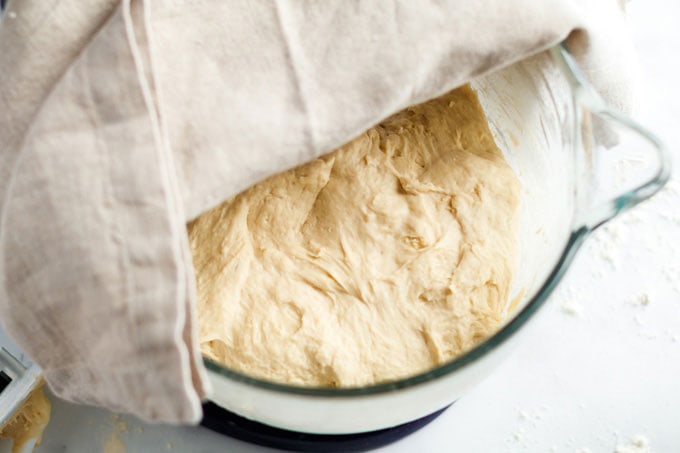
- Divide dough into 2 (or 3 if you want smaller loaves) pieces.
NOTE: This dough does not require kneading.
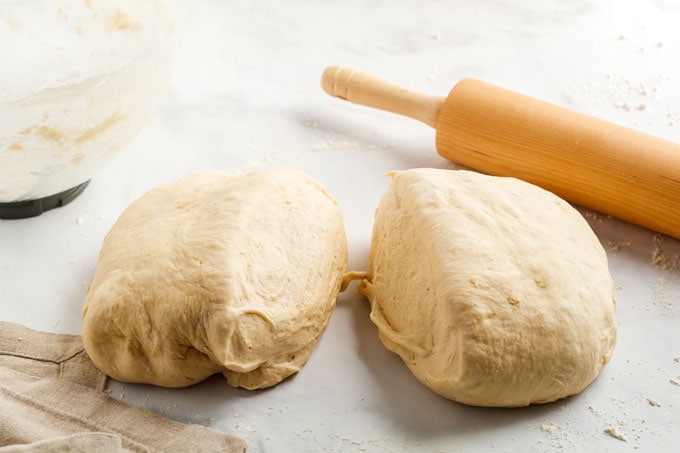
- Roll out each piece on a floured surface into the length desired then roll up length wise like a jelly roll.
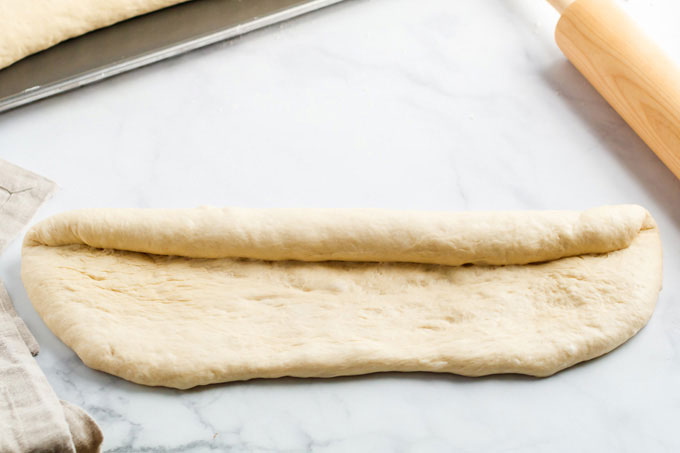
- Put on a greased cookie sheet, sealed side down, and tuck the ends under. Slash the top diagonally across the top every couple of inches with a sharp knife.
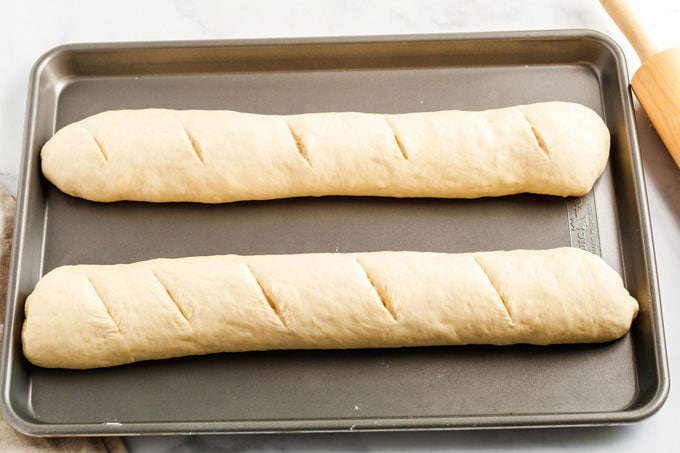
- Cover and let loaves rise 30 more minutes.
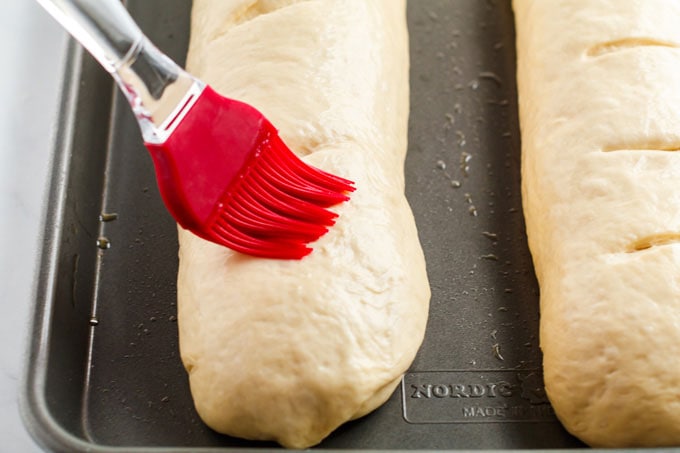
- While loaves are rising, preheat oven to 400 degrees Fahrenheit.
- Whisk the egg white and brush over the top of loaves.
- Bake for 25 – 30 minutes.

How to Make Italian Bread in a Bread Machine
Several people have asked if this Italian bread can be prepared in a bread machine. We were able to test it successfully and have provided the instructions below. Please note, the preparation of the dough is in the bread machine, but you will still remove the dough, form a loaf, and bake it in your conventional oven.
- Using the printable recipe below, cut the ingredients in half, and eliminate the water and sugar step used for proofing the yeast.
- Put 1 cup of water (110 F) and 1/4 cup oil in the bread machine bucket (make sure the paddle is on).
- Add 4 1/2 teaspoons sugar and 1 1/2 teaspoons salt.
- Gently add 3 cups flour over the water mixture so that it is all covered.
- Place 2 1/4 teaspoons (one packet) of yeast on top of flour with nothing else touching it.
- Place bucket in bread machine and enter dough cycle.
- When it beeps, take out and roll dough, adding more flour if needed.
- Roll up (follow instructions in printable recipe for forming loaf) and place on baking sheet, add slashes to top, and cover with towel to let rise (again, according to recipe).
- Brush with egg white and bake at 400 F (see recipe instructions below).
How to Enjoy this Italian Bread
There are plenty of dinners that we like to eat this homemade bread with, and they aren’t all Italian meals! I’ve been known to sop up the juices of my favorite pork sirloin roast using a hunk of this bread.
A big bowl of Italian Sausage Tomato Orzo Soup or my Cheddar Cheese Potato Soup screams for a piece of warm, buttered bread. It’s also amazing with this Zuppa Toscana for those Olive Garden fans out there! Another dinnertime favorite is this Chicken Cacciatore, and it’s great to have a hunk of bread for dipping into the sauce.
Try our new Crockpot Lasagna, it would be perfect with this bread!

Need more ideas? Find all my dinner recipes here!
What Our Readers Are Saying
Never baked bread before? Want to make sure before you invest the time and ingredients? Here’s just a small sampling of what our readers are saying about this recipe! You can find more reviews in the comments down below!
“I have made this twice and it is very tasty, good crust and soft inner not dense , very good flavor, I have been baking bread for 40 years, this is in the top five, Thanks.” ~ Thomas
“By far one of the best and easiest bread recipes I have come across!! Dough comes out perfect and is so easy to roll!! So glad I came across this recipe it’s a game changer.” ~ Tracy
“This bread was so, so delicious! I am proud of myself for going through with it. I was scared to do it and usually need video ( visual learner ) but went ahead and one of the two loaves is already gone! I wish I could attach a pic! I will make this over and over!” ~ Desiree
“I never post reviews… but after making this, I had to!!! I only had bread flour, so used that… but that was the only deviation. I followed the recipe exactly. The bread came out PERFECT! Crispy outside and moist inside. This is some of the best bread I’ve ever made. It will definitely be made again. Thank you!!” ~ Terri
“‘This is a million times better than store bought bread’
‘You have to make this every time we have pasta now’
‘Nom nom nom…’Feedback from my family after serving them this bread for dinner. Excellent recipe!” ~Dave
“OMG! I made this bread today and have to say this is the BEST bread I have ever made, and I’ve tried a lot of recipes! It was very light and fluffy yet just crispy enough on the crust. The only changes I made were I used bread flour and only used 2.5 tablespoons of the sugar instead of three. Thank you for sharing this! I am throwing away all my other bread recipes!” ~ Nadine
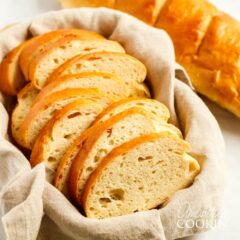
Homemade Italian Bread
IMPORTANT – There are often Frequently Asked Questions within the blog post that you may find helpful. Simply scroll back up to read them!
Print It Pin It Rate ItIngredients
- 1 ½ tablespoons active dry yeast 2 packets
- ½ cup warm water
- ½ teaspoon granulated sugar
- 2 cups hot water hot to the touch, not boiling
- 3 tablespoons granulated sugar
- 1 tablespoon salt
- ½ cup vegetable oil
- 5-6 cups all-purpose flour add more if needed to get to a pliable dough
- 1 large egg white for brushing on loaves
Before You Begin
- If your dough is still super sticky, you can add small amounts of flour until the dough just comes together.
- You can use the packets of active dry yeast available at any grocery store. I bake a lot of bread, so I prefer to by SAF instant yeast in larger packages. If you use active dry, just follow the instructions in the recipe and let it sit for a few minutes to proof (it will get a little foamy).
- When a bread recipe calls for warm water, the temperature should be around 110 degrees F. If the water is too hot it will kill the yeast, and too cold will delay the rise process.
- Use regular white granulated sugar for this recipe.
- In a separate step, you’ll also use hot water in this recipe. Since you are mixing it with other ingredients before adding the yeast mixture it will be fine. You want hot tap water, not boiling water.
- Regular everyday table salt is used, not Kosher or sea salt.
- This recipe calls for vegetable oil, but olive oil can also be used.
- We are using all-purpose flour, white not wheat, to make this bread.
Instructions
- Dissolve yeast, 1/2 cup warm water, and 1/2 teaspoon granulated sugar in a small bowl.
- In a large bowl or stand mixer, combine 2 cups hot water, 3 tablespoons granulated sugar, the salt, and the oil. Add 3 cups of flour to the mixture in this large bowl/mixer and mix well. Stir in yeast mixture.
- Add 2 – 3 cups more flour and mix until well blended. (At this point your dough will still be quite sticky). Leave in bowl, cover with a towel and let rise for 1 hour. (If using a mixer, remove the bowl from the mixer and cover. Otherwise your paddle attachment or dough hook will get covered in dough when it rises). NO KNEADING IS REQUIRED.
- After the rise, if the dough is too sticky to handle, add more flour until its workable. For some people this can be up to a cup or more! Just don't dry out the dough. Add by quarter cupfuls until its workable.
- Divide dough into 2 (or 3 if you want smaller loaves) pieces. Roll out each piece on a floured surface into the length desired then roll up lengthwise like a jelly roll. If it's still too sticky, add more flour until it's workable but not dry.
- Put on a greased cookie sheet, sealed side down, and tuck the ends under. Slash the top diagonally across the top every couple of inches with a sharp knife.
- Cover and let loaves rise 30 more minutes.
- While loaves are rising, preheat oven to 400 degrees Fahrenheit.
- Whisk the egg white and brush over the top of loaves.
- Bake for 25 – 30 minutes.
Nutrition
This recipe was originally published here on January 28, 2009
Amanda Davis
Latest posts by Amanda Davis (see all)
- Roasted Turkey - November 14, 2024
- Pumpkin Cinnamon Chip Cookies - November 11, 2024
- Deviled Eggs - November 4, 2024

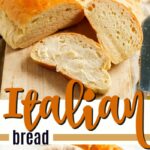
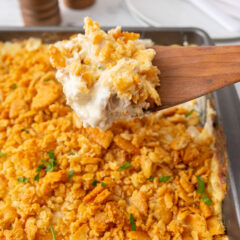
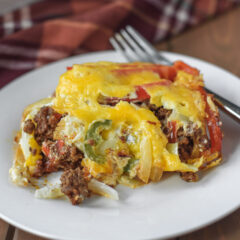
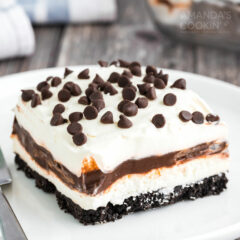






Meg says
Suggested alternatives for the egg white wash? I can’t eat eggs. Thanks!
Amanda Formaro says
Melted butter! :)
Shannon Veach says
I whipped butter with olive oil, garlic & rosemary for the top, it was amazing! Thanks for the wonderful recipe!!
Amanda Formaro says
Love the topping idea!!
Wmom23 says
I made this bread per the instructions. I didn’t read any of the comments first, which I usually do, and I wish I had, it would have saved me some grief. I chose to make this recipe because it sounded so easy and relatively (1 hr rise??) fast. It’s a risk because 6+ cups of precious flour (the supermarkets around here do not have any flour) is an investment. I’m an experienced cook and baker. I make a lot more pizza dough than bread dough, but I do make bread or rolls at least a couple times a year.
The positives: The bread comes together quickly, and with no kneading and short rising times, it’s a bread that you can whip up with Sunday dinner. The bread I made (exactly to recipe – used olive oil) was good – dense like other have said. The inside was very soft, like sandwich bread. Unfortunately the bottom burned, and so you had to either pull the burned part off or eat it and it impacts the flavor.
The feedback: The dough was quite sticky. In step 3, it says that it will still be quite sticky, so I thought that all was well. After the hour rise, the dough was to the top of my kitchenaid bowl, and all bubbly and loose – nothing like what the picture looks like. I poured it out of the bowl onto a silicone mat covered with flour – I was only able to touch it with floured hands or else it would stick. But, it was “together” and it was “pliable”. I didn’t read the notes about adding flour until I got to the bottom of the recipe. So, my feedback is that you need more direction on how the dough should look and feel.
Next, I pulled it in half, and started rolling it out – when I was done with the first piece, I found that it was too long for my biggest baking sheet. I had to lay it cross-wise. So, my feedback is that in step 4 you should specify that the “length desired” should not be more than 14″ (common length of a cookie sheet or jelly roll pan is 15″) – to be on the safe side, I’d say 12″, then you don’t have to worry about it baking over the sides like mine did.
Finally, it would have been nice if the recipe had some finishing directions – the bottom of my loafs burned to black while the rest of the loaf was a nice golden brown. I had set the timer for 30 minutes, but checked at 25, and they looked great – not over done at all. How can you tell that they are done? Why would the bottoms burn? So, in addition to some more detail about the cooking, it would be nice to know how long to cool, when can you cut it (some breads turn to crumbs if you cut too soon or too late), can you freeze it and if so how long?
Not sure if I’ll make it again – I would if I could figure out why the bottom burned. I took some pictures: https://photos.app.goo.gl/gMUbFWHikCru5apN7
Amanda Formaro says
Thanks for your feedback. The burnt loaves are likely due to your oven. There have been hundreds of people that have made this recipe successfully per the instructions and your the first person I’ve heard that their loaves burnt on the bottom. From what you describe, it almost sounds like your yeast was OVER active, which seems unusual. But it seems like with the rise your describe and the bubbling, sounds like something with your ingredients wasn’t right. I’m sorry you had trouble!
Tsynka says
I was reading the comments from Wmom23 and, although my loaves turned out very well, I had a similar experience with the yeast. It was pretty damn exciting – i thought i was growing a monster. Its probably not the same thing but i think i figured out what made the difference with mine and that was the yeast itself. As Wmom23 mentioned, its difficult to find many baking supplies these days – who knew we would all turn to cooking and baking for entertaining? Anyways, in my store it’s not only difficult to find flour but also baking soda, powder, and yeast. In my store there’s a sign in the baking aisle saying “yeast, baking soda and powder available in bakery”. There, they had bags of those things plus bread and cake flour in pre-packaged bags and containers, as if they’d been taken from the bulk section (which is closed and never had yeast before anyway). But what I’ve taken a very VERY long time to say is that I think they may be commercial grade. I’ve never seen or heard of a yeast acting like that. I can hardly wait to try something else though.
Amanda Formaro says
Oh wow, that’s crazy! And honestly what a brilliant idea of your store to offer it from the bakery.
Wmom23 says
My yeast was some that I had bought at least 6 months ago, maybe more. Regular Fleishmann’s packages. I think that it should have had more flour mixed in before the rise – be less wet.
I asked for advice about my burned bottoms on a cooking group to which I belong, and many of them also suspected my oven. But, I have no problem with other baked goods or other baking burning. Everything else comes out per recipe. Someone else said that they thought my loaves looked overdone on top as well. I guess that could be, but the rest of the bread was great – got rave reviews from the family. The taste and texture did not seem overdone.
Carmella Paulsen says
The easiest bread to make. Was simply delicious and will be making it again
Amanda Formaro says
Thanks so much for the great feedback Carmella!
Sophie says
Hi, I am planning to make this recipe today but I am confused as it doesnt mention any kneading… will it not be dense if it’s not kneaded?
Amanda Formaro says
This is a no-knead recipe!
Latrice Steffen says
I have no clue when baking so I am asking so I am educated on the various types.
All-Purpose vs. Bread Flour
Will it make a difference if I use bread flour?
Vegetable vs. Olive Oil vs. Canola Oil
How much will the flavor be effected if I used olive oil or canola oil? I’ve made recipes with olive oil instead of the vegetable oil and the taste was affected and not in a good way. Thank you in advance for the information provided.
Amanda Formaro says
Vegetable and canola oil do not have much difference in taste, but olive oil does. You can substitute bread flour and all-purpose flour one-to-one without a problem! :)
Carmen Crupi says
My bread came out delicious, although very big lol I didn’t understand what you meant by “mixing a few strokes a couple of times during the hour.” What do you mean by strokes?
Amanda Formaro says
Hi Carmen! By strokes I just mean turns :) So glad you liked it!!
Ashley says
I was just wondering if I use fresh yeast if I need to let the bread rest longer?
Amanda Formaro says
It behaves the same way so you can follow the instructions as directed :)
Mike says
I’ve tried this twice and the bread didn’t rise. It came out heavy and dense. I used 110 degree water when mixing the yeast and also tried kneading the bread and placing in a warm oven for an hour. Still no luck
Amanda Formaro says
Hi Mike! Sorry you had trouble. Here’s a great article you might find helpful https://mikeswindow.com/notebook/5-reasons-your-homemade-bread-is-dense/
Kathy says
Easy, delicious, still great the next day!
Amanda Formaro says
Awesome thanks Kathy!
desiree morris says
This bread was so, so delicious! I am proud of myself for going through with it. I was scared to do it and usually need video ( visual learner ) but went ahead and one of the two loaves is already gone! I wish I could attach a pic! I will make this over and over!
Amanda Formaro says
Woohoo, way to go Desiree! So glad you had fun and enjoyed the bread!
Dee Lehr says
Wonderful bread. Just wish the instructions were a little clearer. I assume when you leave the bread in the bowl for the first rise you cover it, written instructions don’t say but picture shows it. Do you leave the hook in the bowl and mix it that way or with your hand or a spoon during rising. Second rising time I assume is uncovered because the dough is sticky. Mine came out fantastic but I am a seasoned cook, a new one might not understand exactly what to do.
Amanda Formaro says
Thanks! I’ve updated the instructions, it definitely should have had a towel.
Laurie Corbett says
Hoping to make this this afternoon but I’m confused by the yeast. There are 2 1/4 tsp in a packet so is it two packets or 1 1/2 tsp?
Amanda Formaro says
Hi Laurie! It’s 1 1/2 TABLEspoons, not teaspoons :) So two packets will be perfect!
lisa says
Very easy recipe but i think i did something wrong…bread came out really thick and heavy. It tasted delicious but it was extremely heavy
Ashley says
Does the salt crystalize on the top? I made this today and after I baked it it had crunchy crystals on top of it.
Ann says
Can I half this recipe for 1 loaf?
Amanda Formaro says
Yes that should be fine!
Karrie Riemer says
Love this bread recipe!!! The first time I made it I cut the recipe in half. I forgot this time and am wondering if I can keep half in the fridge overnight and bake the second loaf tomorrow? Thanks!!
Amanda Formaro says
Yes that should be fine as long as it’s just one day in the fridge. It should stop or definitely slow the rise process :)
Christina P says
I’ve been terrified to tackle bread making and I finally found this recipe that seemed very easy to follow. The thing that helped the most was your tips and notes added in. Thank you so much for this recipe, it came out excellent! It didn’t look as visually appealing as yours but it was my first time! Everyone loved it, the first loaf was gone almost immediately. I made this with Chicken Parm and a homemade pasta sauce. The only thing I did different was instead of 3tbsp sugar I used 1.5tbsp because I’m not a fan of sweet bread. I will definitely be using this recipe again! Thank you!
Amanda Formaro says
Hooray, that’s awesome! And honestly, it does not matter what it looks like! So glad you guys loved it!
Kathy says
I’ve used this recipe several times and it turns out great. Can I turn my loaves into rolls by cutting the dough before rolling it up or afterward? Should they be spaced somewhat before the second rise? I want to share more of this goodness with family and friends.
Amanda Formaro says
Oh I haven’t tried that! I would think you could do that, and maybe even put it into a muffin tin. I would like to suggest my pull apart dinner rolls. everyone loves these and my family insists on these every holiday or special occasion! https://amandascookin.com/homemade-pull-apart-dinner-rolls/
Michelle S. says
I want to turn this into rolls also. Did you ever do it yourself? If so, how did you go about it and how did they turn out?
Terri Osburne says
I never post reviews… but after making this, I had to!!! I only had bread flour, so used that… but that was the only deviation. I followed the recipe exactly. The bread came out PERFECT! Crispy outside and moist inside. This is some of the best bread I’ve ever made. It will definitely be made again. Thank you!!
Amanda Formaro says
Awesome, thank you so much Terri! :) :)
Jake says
I don’t understand why there’s such a variation in the amount of flour. Baking is precise, and there’s a difference of an entire cup. That’s a percent error of over 15%. I understand it varies if your kneading and people use differing amounts slightly on the bench top, but in the actual recipe for the dough? Kinda crazy. The stickiness of your dough in the bowl shouldn’t vary that much, you either use 5 cups or 6.
Amanda Formaro says
There are a lot of variations when it comes to baking bread. They include, but are not limited to, the way flour is measured, the temperature of your kitchen, your elevation where you live, and even the barometric pressure.